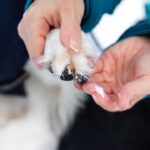Why Does My Dog Have Milk But Not Pregnant
Why Does My Dog Have Milk But Not Pregnant?
If you’ve noticed your female dog producing milk but she hasn’t mated or given birth recently, you might wonder what’s going on. While it’s not uncommon for dogs to have lactation outside of pregnancy and nursing, it can be a sign of an underlying health issue that requires attention. In this article, we’ll explore the reasons why dogs may develop milk without being pregnant, how to tell if it’s normal or abnormal, and what you can do about it.
Understanding Canine Lactation
Lactation is the process by which mammary glands produce and secrete milk, which contains nutrients and antibodies that help nourish and protect newborns. In mammals, including dogs, lactation is triggered by hormonal changes that occur during pregnancy and after giving birth. The hormones prolactin and oxytocin play key roles in stimulating the mammary glands to produce milk and release it from the nipples.
Typically, lactation in dogs lasts for several weeks to a few months after whelping (giving birth) or until the puppies are weaned. During this time, the mother dog may produce large amounts of milk that can leak or squirt out even when she’s not nursing her pups. This is normal and expected.
However, sometimes dogs can start lactating even when they’re not pregnant or nursing. This is called pseudopregnancy (false pregnancy) or false lactation, and it can happen for various reasons.
Causes of False Lactation in Dogs
1. Hormonal imbalances: Dogs that have irregular estrous cycles or persistent estrus (heat) may experience fluctuations in their hormone levels that mimic those of pregnancy. This can cause their mammary glands to enlarge and produce milk, even though there are no fetuses to feed. Certain medications or medical conditions that affect hormone production or regulation can also trigger false lactation.
2. Psychological factors: Dogs that have a strong nurturing instinct or maternal drive may exhibit behaviors and physical changes that resemble pregnancy, even if they haven’t mated. This can include nesting, licking their genital area, carrying around toys or stuffed animals as if they were puppies, and producing milk. Some dogs may also develop pseudopregnancy after being exposed to puppies or other lactating animals.
3. Infections or tumors: Dogs that have infections or growths in their mammary glands or reproductive system may experience abnormal lactation as a symptom. These conditions can range from benign cysts or abscesses to malignant tumors that require surgery or chemotherapy.
4. Nutritional deficiencies: Dogs that are lacking certain nutrients in their diet, such as calcium, may develop hypogalactia (low milk production) or agalactia (no milk production). This can lead to health problems for both the mother and her pups if she’s nursing them.
5. Breed predisposition: Some dog breeds are more prone to developing false pregnancy or lactation than others. These include breeds with a history of being used for breeding or nursing, such as Beagles, Bichons Frises, Boxers, Dalmatians, Doberman Pinschers, English Springer Spaniels, Poodles, Weimaraners, and Yorkshire Terriers.
Diagnosing and Treating False Lactation in Dogs
If you notice your dog producing milk but she’s not pregnant or nursing, it’s important to consult with a veterinarian to determine the underlying cause and appropriate treatment. Your vet may perform a physical exam, blood tests, ultrasound imaging, or other diagnostic procedures to rule out any medical issues.
Depending on the cause of your dog’s false lactation, your vet may recommend various treatments or interventions. These can include:
– Medications to regulate hormones
– Nutritional supplements or changes
– Surgical removal of tumors or infected glands
– Behavioral modification or environmental enrichment
– Supportive care for nursing puppies, if applicable
In some cases, your vet may advise you to wait and see if the lactation resolves on its own, especially if it’s mild and not causing any discomfort or complications. However, it’s important to monitor your dog closely for signs of infection, inflammation, pain, or behavioral changes that could indicate a more serious problem.
Preventing False Lactation in Dogs
While there’s no surefire way to prevent false lactation from occurring in dogs, there are some steps you can take to reduce the risk and promote overall health:
– Spay your female dog before her first heat cycle to prevent hormonal fluctuations and reduce the risk of mammary tumors.
– Provide a balanced and nutritious diet for your dog that meets her age, breed, and activity level requirements.
– Keep your dog physically and mentally stimulated with regular exercise, playtime, training, and socialization.
– Avoid exposing your dog to other animals that are pregnant or nursing unless it’s necessary for breeding purposes.
– Schedule regular wellness exams with your vet to monitor your dog’s health status and catch any potential issues early on.
Conclusion
False lactation in dogs can be puzzling and concerning for pet owners who want the best for their furry companions. By understanding the causes, symptoms, diagnosis, treatment options, and prevention strategies of this condition, you can help ensure that your dog stays healthy and happy. Remember to always consult with a qualified veterinarian before trying any home remedies or treatments on your own. And don’t forget to give your dog plenty of love and attention, whether she’s lactating or not!



